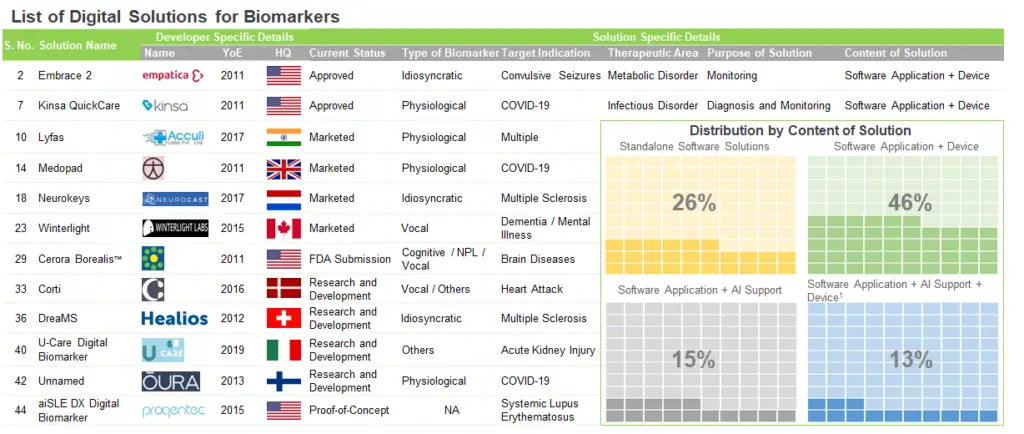
Risk prediction biomarkers are of two types; firstly, there are those that based on current physiological conditions, are able to predict the likelihood of disease, and those that enable early diagnosis of clinical conditions prior to the onset of characteristic symptoms. The second category of digital biomarkers are related to specific diseases. Although there is a significant overlap, they can be further segmented into biomarkers that are used for diagnosis and those that enable healthcare professionals to monitor a specific disease during the course of treatment.
What is Current Developmental Scenario Across the Globe?
Even though efforts for development of digital biomarkers have been undertaken by players based all across the globe, most of the developers engaged in this domain (~70%) are headquartered in North America. Within this region, majority of the developers are based in the US (20). The players been actively engaged in raising investments and collaborating with the other industry / non-industry players to aid the development of these modern solutions. These activities have resulted in a significant increase in the number of digital biomarkers in the recent years. Over 70% of these modern solutions have been launched in the last three years (since 2018).

Key Strategies to Tackle COVID-19
In the current pandemic scenario, medical professionals are trying to identify digital biomarkers that can facilitate the successful screening / diagnosis of COVID-19 patients, remotely. For instance, the National Institutes of Health (NIH) has tasked physIQ with developing and validating an algorithm, which can use existing wearable biosensor-derived analytics (generated by the company’s pinpointIQ cloud platform) to discover a novel digital biomarker for COVID-19 associated decompensation. In this regard, it is worth noting that the development of tools to capture digital biomarkers and analyze them, requires multidisciplinary (including computer science and engineering, as well as neology and medicine) expertise. Currently, several successful start-ups claim to be involved in designing and developing the necessary software / hardware solutions for the abovementioned purposes. Most of these companies have also received significant capital investments to support their respective product development initiatives. Below I’ve copied an illustration highlighting the effect of COVID-19 pandemic on overall market for digital biomarkers.
cloud platform) to discover a novel digital biomarker for COVID-19 associated decompensation. In this regard, it is worth noting that the development of tools to capture digital biomarkers and analyze them, requires multidisciplinary (including computer science and engineering, as well as neology and medicine) expertise. Currently, several successful start-ups claim to be involved in designing and developing the necessary software / hardware solutions for the abovementioned purposes. Most of these companies have also received significant capital investments to support their respective product development initiatives. Below I’ve copied an illustration highlighting the effect of COVID-19 pandemic on overall market for digital biomarkers.

Yes, COVID-19, to Greater Extent, is Responsible for Rise in Demand for Digital Biomarkers
Given the current situation, I believe that a significant proportion of the healthcare budget is being allocated to develop and distribute digital health solutions, including digital biomarkers. Further, the ongoing pandemic has boosted the adoption of digital solutions (as the patients are not able to physically access their healthcare teams). This has enabled a majority of developers to develop / modify their offerings to be used remotely. Once digital biomarkers get adopted in mainstream healthcare, the demand for such solutions is likely to increase in near future as well.
The post Digital Biomarkers: Is Efficient Remote Monitoring of COVID-19 Patients Primary Reason for Incessant Rise in Demand? appeared first on Blog.
